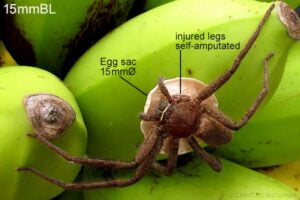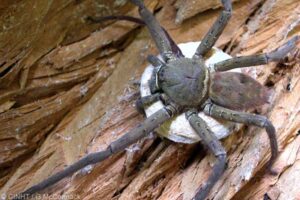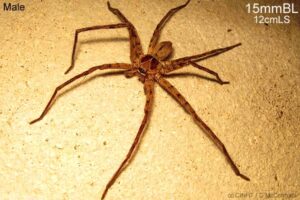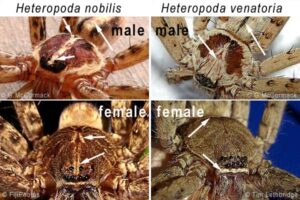Gerald McCormack, CINHT
The largest spiders in the Cook Islands are the two huntsman spiders: the Brown Huntsman (Heteropoda venatoria), and the Noble Huntsman (Heteropoda nobilis). Their long slender legs have a span to about 12cm, although they have relatively small bodies – to 3cm long.
Huntsman spiders do not build webs to catch their prey. They are nocturnal hunters, actively searching for insects, especially cockroaches, which makes them useful around the house. When they detect an insect they give chase with tremendous speed and agility, and can jump as far as 20cm to land on the prey. The typical outcome of a chase is for the spider to embrace the insect as it subdues and kills it with venom from its fangs. Like other spiders, it then injects the prey with digestive enzymes to dissolve its internal tissues into a nutritious soup for it to drink.
Because they are out and about at night, they are often seen when a light is turned on. For the tropical newbie their threatening size is made worse as they dash about erratically to escape. The hairs on their feet are subdivided into countless filaments that can adhere to smooth surfaces enabling them to run across windows and upside-down across ceilings.
A huntsman’s first reaction in a confrontation is to escape, but if cornered they will defend themselves. In defence they use their fangs to give a mild sting. The resulting pain and inflammation usually lasts about five minutes – or, at least, that is what a study of 75 huntsman stings showed in Australia. If you are especially sensitive to stings and the pain and tenderness persist beyond ten minutes, you should seek medical advice.
Spiders are delicate creatures. If you break their legs they usually bleed to death before they can undertake repairs. Spider legs have muscles to bend them inwards but rely on blood pressure to extend them outwards. When the blood pressure is lost, as in death, they curl into a ball.
 From a serious wound the blood continues to pump out through the hole because spiders have no clotting agent. If a spider can find a safe place, it can stop the blood loss by disconnecting the injured leg at its basal joint, which has a self-sealing valve. Young spiders can regenerate a lost leg the next time they moult their skin.
From a serious wound the blood continues to pump out through the hole because spiders have no clotting agent. If a spider can find a safe place, it can stop the blood loss by disconnecting the injured leg at its basal joint, which has a self-sealing valve. Young spiders can regenerate a lost leg the next time they moult their skin.
The easiest way to remove a spider and put it outside is with the help of a container. Choose a large transparent container to avoid chopping off its legs. After placing it over the spider, gently slip a piece of stiff paper, card or an envelope underneath to trap it in the container. When outside, put the container on the ground and on its side to let the spider run away. If you try to shake the spider out of the container it will most likely run up your arm!
Some spiders are more dangerous
There are 76 spiders recorded in the Cook Islands and only one is known to deliver a moderately painful sting when threatened, like when squashed under your clothes. This is a new invasive, the web-building Asian Spinybacked Spider (Thelacantha brevispina), which was first recorded in Mangaia in 2006 and since then on Rarotonga, Ātiu and Miti‘āro. It is not fatal, but if adverse reactions persist you should consult a doctor.
The only spiders in Polynesia that are seriously dangerous for people are: the native Katipo spider in New Zealand, which is a relative of the dangerous Australian Redback and American Black Widow and the Brown Widow of tropical USA, Australia and South Africa, which arrived in Rapanui in the 1990s and was sighted in the Cook Islands in May 2014.
The huntsman family
There are about a thousand spiders that at first glance look rather like our huntsman spiders and they are all in the huntsman family (Sparassidae). Here we will only consider the 220 closest relatives, namely those in the genus Heteropoda.
The huntsman spider in Hollywood
The huntsman spider known to New Zealanders as the Avondale Spider (Delena cancerides) is a distant relative of the Cook Islands Heteropoda spiders. It is a native of Australia that established in Avondale in the 1920s, and it is unusual, as it lives in large colonies. It has twice the leg-span of our huntsman spiders and it had a moment of fame when 374 spiders from Avondale starred in Steven Spielberg’s 1990 horror-comedy movie Arachnophobia.
The film was a financial success but did nothing to endear these harmless spiders to people, especially those with a phobia of spiders or arachnids. A strong spider phobia is an uncontrollable fear of spiders regardless of whether they are harmful. When you encounter an arachnophobic confronting a spider, you need to be especially patient as you gently coax them away from each other.
The 220 Heteropoda spiders are all native of the topical areas of Southern Asia (India) eastward through Southeast Asia to Papua New Guinea, and northward to southern Japan, and southward through Queensland to northern New South Wales. All except two have remained in their respective homelands.
The exceptions are the two huntsman in the Cook Islands. Heteropoda venatoria, a native in the triangle of China, Japan and Indonesia has travelled extensively with cargo and established itself throughout the tropics of the Americas, Africa, Australia, and across the Pacific as far eastward as Cook Islands, French Polynesia and Hawai‘i.
It is the only Heteropoda to establish in Florida where it has become well known. Americans call it the Brown Huntsman (as we will), Brown Giant Crab Spider or the Banana Spider, the latter referring to the cargo they often accompany.
The male Brown Huntsman has longer legs and a smaller abdomen and clear markings on its body. The female with a larger abdomen and shorter legs is uniformly dull brown, with a cream moustache and cream bar across the rear of her thorax.
Our other huntsman Heteropoda nobilis, the Noble Huntsman is a more selective traveller. It is a native of Australia and it has hitched rides to a few Pacific islands from Vanuatu and Fiji eastward to the Marquesas, including the Cook Islands. Although not a great explorer, it nevertheless is the only other Heteropoda huntsman to move out of its homeland.
The Noble Huntsman is similar to the Brown Huntsman. A small but definitive difference is that both male and female have a slender cream stripe that starts between the upper eyes.
Mating and growing
The male Brown Huntsman detects the presence of a female by her perfume or pheromone, and he then hums a soothing and enticing tune by vibrating his belly. If she thinks he sounds OK then she approaches and he will mount several times during the next day, each mounting lasting an hour or two while he uses the long pedipalps on his head to transfer the sperm. In the only detailed study (in a laboratory) the females usually ate the male after mating, although the cannibalism might have been aggravated by being kept in an enclosed space. Nevertheless, even in the wild, huntsman mating is an extreme sport for males.
About two weeks after mating the female spins a silk plate, about 15mm in diameter, on the ground. She then places 200 to 400 eggs on it before spinning a silken cover to form a discus-shaped egg sac. She does not eat while she carries the egg sac under her body for the next month, at which time the case is opened along the edge and the young spiderlings run free.
The young spiders grow in a series of steps. About once a month their skin splits across the back of the thorax and they emerge with a soft new skin, which they pump up to a larger size before it sets. While the skin is soft they hide because they are defenceless and vulnerable.
Each spiderling takes about ten months to become an adult, having developed ten new skins. As an adult, if not eaten by a predator, they can expect to live a year or, if lucky, a couple of years. Males need more luck then females.
Identifying the two species
The two species are identified by the differences in their cephalothorax. The male Heteropoda nobilis has a pale, narrow central stripe extending through the eyes to the rear edge. It also has a broad pale stripe on the abdomen.
The female Heteropoda nobilis has its central stripe split and broken while Heteropoda venatoria has a uniformly, brown cephalothorax and a bolder, white moustache below the eyes.
Citation
McCormack, Gerald (2021) Huntsman spiders – harmless and useful. Cook Islands Natural Heritage Trust. https://cinature.org/2021/02/21/huntsman-spiders…mless-and-useful/
First published CI News (January 2010), updated (January 2024) Identification of the two species added.














